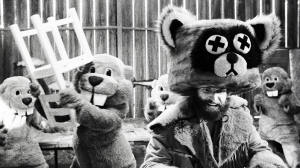What do hundreds of beavers have to do with the future of movies?
 Send a link to a friend
Send a link to a friend
 [November 23, 2024]
By JAKE COYLE [November 23, 2024]
By JAKE COYLE
NEW YORK (AP) — Hard as it may be to believe, changing the future of
cinema was not on Mike Cheslik’s mind when he was making “Hundreds of
Beavers.” Cheslik was in the Northwoods of Wisconsin with a crew of
four, sometimes six, standing in snow and making his friend, Ryland Tews,
fall down funny.
“When we were shooting, I kept thinking: It would be so stupid if this
got mythologized,” says Cheslik.
And yet, “Hundreds of Beavers” has accrued the stuff of, if not quite
myth, then certainly lo-fi legend. Cheslik’s film, made for just
$150,000 and self-distributed in theaters, has managed to gnaw its way
into a movie culture largely dominated by big-budget sequels.
“Hundreds of Beavers” is a wordless black-and-white bonanza of slapstick
antics about a stranded 19th century applejack salesman (Tews) at war
with a bevy of beavers, all of whom are played by actors in mascot
costumes.
No one would call “Hundreds of Beavers” expensive looking, but it’s far
more inventive than much of what Hollywood produces. With some 1,500
effects shots Cheslik slaved over on his home computer, he crafted
something like the human version of Donald Duck’s snowball fight, and a
low-budget heir to the waning tradition of Buster Keaton and “Naked
Gun.”
At a time when independent filmmaking is more challenged than ever,
“Hundreds of Beavers” has, maybe, suggested a new path forward, albeit a
particularly beaver-festooned path.
After no major distributor stepped forward, the filmmakers opted to
launch the movie themselves, beginning with carnivalesque roadshow
screenings. Since opening in January, “Hundreds of Beavers” has played
in at least one theater every week of the year, though never more than
33 at once. (Blockbusters typically play in around 4,000 locations.)
More than half of its approximately $500,000 in ticket sales came after
the movie went to video-on-demand.

Daniel Scheinert, the co-director of the best picture-winning
“Everything Everywhere All at Once,” recently called “Hundreds of
“Beavers” “the future of cinema.” That bold pronouncement, which
ricocheted around film blogs, might seem extreme for a movie about a guy
wearing a comically large beaver hat.
But in a shrinking movie industry, DIY microbudget filmmaking may
increasingly be left to fill some of the void left by risk-averse,
corporate-driven Hollywood.
“I hope people can stop shooting things to make them look like
commercials and just get back to more of the nitty gritty and letting
your imagination flow,” says Tews, who also co-wrote the movie with
Cheslik. “I just hope we stop bowing down to Hollywood and thinking
they’re the gold standard. Because they just aren’t.”
[to top of second column]
|

This image released by SRH shows Ryland Brickson Cole Tews in a
scene from the film "Hundreds of Beavers." (SRH via AP)
 The year-to-date box office in North
America is down 11% from last year and about 25% from before the
pandemic. More movies are making a tiny impact in theaters;
according to Franchise Entertainment Research, 41 wide releases in
2024 have grossed less than $3 million — nearly three times the
amount in 2019.
The costs not just to make wide-release films but
to market them has greatly shifted what even indie distributors are
willing to back. Just to get eyeballs on “Gladiator II,” which
carries a $250 million budget, Paramount Pictures took the
extraordinary step of running a trailer of the film simultaneously
on more than 4,000 platforms, including TV networks, radio stations
and digital outlets. For even the biggest movies, it’s hard to get
people’s attention.
In such an environment, where the expense of making and marketing a
movie is potentially prohibitive for everything but the safest of
bets, more filmmakers are questioning the economics. That’s
especially because after last year’s strikes, movie production
hasn’t rebounded. In a contracting movie industry, many remain out
of work.
Brady Corbet, director of the highly touted “The Brutalist,” a 3
½-hour epic shot in VistaVision, for less than $10 million, has
preached that smaller budgets don’t have to mean less artistic
ambition. Sean Baker, whose breakthrough film “Tangerine” was shot
with iPhones, has argued movie budgets can come down without
sacrificing what’s on the screen. His $6 million “Anora” is one of
the year’s most acclaimed films.
“Right now, it’s panic in LA,” Baker said in an earlier interview.
“I’m like: We don’t have to make films for that much. They don’t
have to cost as much.”
“Hundreds of Beavers” is a more micro example, but it was likewise
made with a strong belief in the big screen. On Dec. 5, the movie
will begin an encore tour in theaters, at some 70 locations. That’s
the widest release yet for “Hundreds of Beavers,” nearly a year
after it opened. They’re calling it “A Northwoods Christmas.”
It’s a victory tour (with a Blu-ray release to follow) for “Hundreds
of Beavers,” a barnstorming indie hit that Cheslik hopes shows
aspiring filmmakers that the same kind of goofy inventiveness that
goes into a TikTok video can be channeled into a movie.
“You still can do whatever you want,” Cheslik says. “No one’s going
to stop you if you take a phone and make a 90-minute timeline
instead of a 30-second timeline."
All contents © copyright 2024 Associated Press. All rights reserved |